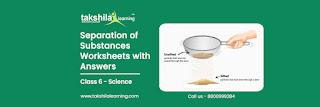Class 6 Science Worksheet separation of substances
Write down the steps for separating sand and water from their mixture?
To separate sand and water from their combination, perform these steps:
- Allow the mixture to sit undisturbed for at least an hour.
- Now the sand has settled.
- Pour the water slowly into a second container to acquire sand at the bottom.
Now that we know so much about the separation of substances from their mixtures, let’s also learn a few more things by attempting the questions below –
1. Fill in the blanks:
- _________ is the technique for removing paddy seeds from their stalks.
- _________ is the procedure of cream separation from milk.
- The procedure of separation of the impurities from the muddy water is known as _________.
- The procedure to obtain salt from seawater is known as __________.
2. State True/False:
- Filtration is the process that can be used to separate sugar from tea.
- Decantation is a technique for separating grain and husk.
- Filtration is the separation of a milk and water combination.
- The process of winnowing is the separation of a powdered salt and sugar combination.
3. Define the following:
- Sedimentation
- Churning
Read more
Download Worksheet for class 6 science

Comments
Post a Comment
Thank you we will contact ASAP.